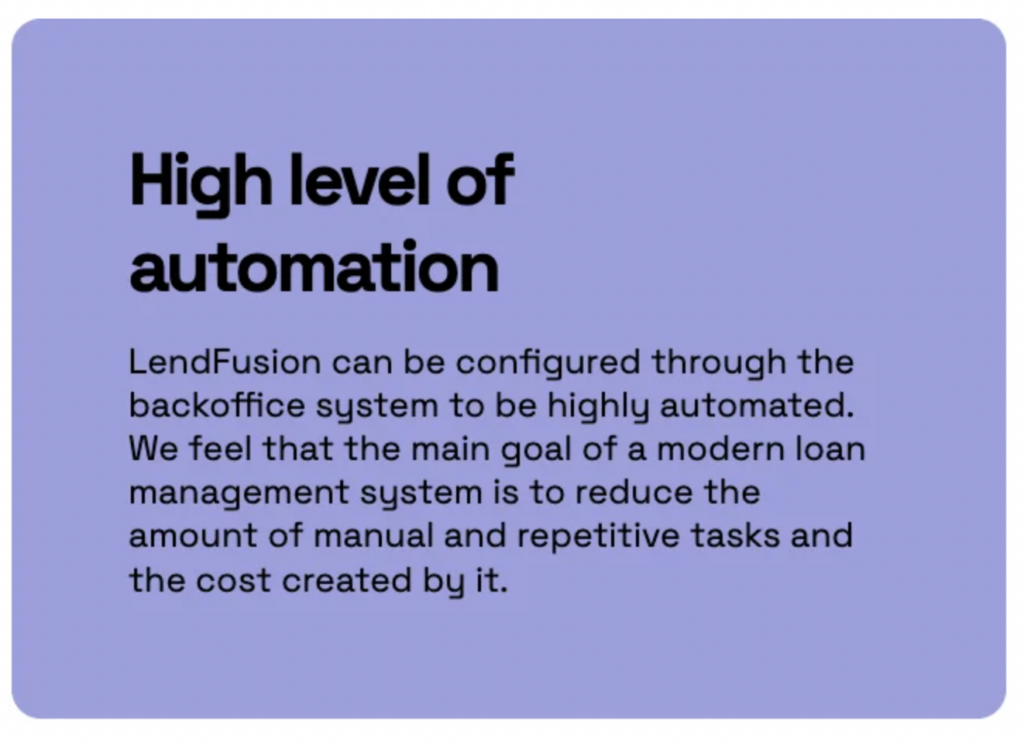Streamlining Credit: 5 Ways to Automate Loan Applications

Automation is the key to a streamlined loan application process, and it represents a huge step forward in the financial industry.
By harnessing the power of technology, established lenders can simplify complex procedures, ensuring that loan applications are processed with unprecedented speed and accuracy.
This not only enhances the borrower’s experience, but also allows lenders to handle a higher volume of loan applications with greater efficiency.
It’s the fastest way to grow your business.
In addition, automation reduces the potential for human error, which can lead to delays and inaccuracies in the loan approval process.
In this article, we share tips on how to automate loan applications to enhance speed and precision while addressing your borrowers’ needs more effectively.
Ready? Let’s dive in.
The Need for Loan Origination Automation
The rapid changes in the lending industry are forcing financial institutions to improve their loan origination processes.
Decreasing profit margins due to higher labor and material costs are pushing CEOs to make important decisions to keep their companies competitive and maintain quality.
Automation is poised to transform the loan origination process, which has long been hampered by manual tasks and inefficiencies.
Especially for lenders that still use Excel to manage their loans.
By implementing solutions to automate lending operations, this approach is steadily gaining traction as a means to improve operational efficiency and customer satisfaction.

Major Challenges in Lending Operations
The loan management process is complex and includes detailed tasks like processing applications, underwriting loans, and servicing loans.
These complexities pose significant challenges for CEOs and loan officers, impacting the overall efficiency of their operations.
Operational bottlenecks and human errors often stem from issues like late payments and labor-intensive manual tasks, which include data entry and document verification.
Benefits of Automation
The implementation of loan origination automation can deliver a high return on investment in its first year by boosting the productivity of loan specialists and slashing operational costs.
Automation of the entire process from data entry to decisioning allows lenders to drastically cut down on manual labor, enhance efficiency, and minimize errors.
As a result, operations become more cost-effective and customer satisfaction increases.

Implementing Loan Management Systems
Using loan management software is transformative for financial institutions, offering a single platform that boosts the efficiency of the whole loan process, from application to payment collection.
But loan management systems do more than just automate tasks:
They also optimize procedures which leads to expedited loan processing, fewer errors, and a superior customer experience.
(–> Click here to get advice on how to choose the right loan management platform).
Features of Loan Management Software
Loan management software is a powerful tool that automates important parts of the loan process, including origination, servicing, and managing customer relationships.
And that is even more important when you offer different types of loans.
Key features of loan management software include collateral tracking, portfolio management, and security regulation compliance, which are critical for a robust lending operation.
Additionally, these systems speed up paperwork and loan distribution by automating communication with borrowers, making the lending process faster and more efficient.

Integration with Existing Systems
One of the most significant advantages of modern loan management systems is their ability to integrate seamlessly with a wide variety of existing financial tools and systems.
These systems are scalable and customizable, allowing them to meet the specific needs of any financial institution and offer a great solution for lending businesses looking to stay up-to-date with new technologies.

Steps to Automate the Loan Application Process
Automating the loan application process involves moving through five important steps:
- Borrower pre-qualification
- Application
- Evaluation
- Approval
- Loan granting
Modern loan management platforms, such as LendFusion, support all these stages digitally, leading to paperless processing that removes the need for physical documents and lowers the chance of manual errors.
Digitizing Borrower Data Collection
Digitizing the collection of borrower data is a key step in improving the loan application process.
Traditional methods, such as paper forms, frequently lead to errors and inefficiencies, underscoring the need for a digital overhaul.
Lenders can enhance data collection efficiency with web-based forms, chatbots, and API integrations.
These tools automatically populate borrower information into Loan Origination Systems (LOS), making the lending process more accurate and smooth.
Streamlining Loan Decisioning
Automated loan decisioning marks a major change in the loan origination process, allowing established lenders to:
- Provide rapid lending decisions based on comprehensive data analysis
- Quicken the processing and underwriting of loans
- Empower lenders to make informed decisions about an applicant’s creditworthiness through an analysis of payment history, assets, and stability.
This change is transforming the lending industry by enhancing the efficiency and accuracy of loan decisions. The flexibility of automated systems allows lenders to tailor the decision-making process to their unique business needs, giving them a competitive edge in the lending market.

Simplifying Loan Disbursement and Servicing
Automation plays a pivotal role in organizing and managing loan applications and stipulations, minimizing the risk of document mismanagement during the disbursement phase.
The lending process is further enhanced during the loan servicing phase, as automated systems and workflows contribute to more efficient customer management, reducing payment issues and fostering greater satisfaction.
Standardized underwriting procedures, resulting from automation, streamline the loan servicing process, ensuring a consistent and efficient experience for both lenders and borrowers..
This is achieved through the implementation of a formalized loan origination process.

Adapting to Industry Regulations and Compliance
Navigating the complex financial regulatory landscape is essential in the lending industry.
Adhering to industry regulations is crucial to maintain trust, avoid legal penalties, and protect against financial losses and reputational harm.
Keeping up with regulatory changes and setting up strong controls are key for financial institutions.
This might involve getting advisory services, investing in technology, or training staff to keep up with changing regulations set by local authorities.
Role of Compliance Teams
Compliance teams are a vital defense within lending companies.
They concentrate on governance, resources, and enforcing compliance policies and processes to ensure lending operations meet the strict standards of regulatory bodies.
It’s crucial to staff these teams with knowledgeable and skilled individuals to effectively handle the compliance workload and challenges.
Digital Transformation and Compliance
The digital transformation in the lending industry brings with it improved monitoring systems that enhance the efficiency of compliance functions.
The benefits of this transformation include:
- Enhanced protection of customer data
- Improved compliance with regulations
- Increased efficiency in the loan origination process
- Lowered risks associated with lending
These advancements in technology and automated systems are instrumental in driving the industry forward.

Case Studies: Successful Loan Origination Automation
Real-world success stories underscore the impact of loan origination automation.
For example, Provira experienced significant improvements after implementing a loan management platform. These benefits include:
- Automating the entire end-to-end lending process
- Improved operational efficiencies
- Set up to launch new products quickly
- Streamlined and standardized processes
This project was completed in just 65 days and successfully tackled the challenges arising from manual processes, including errors and inefficiencies in handling loan documents.

(Read the full case study here: How LendFusion Streamlined Startup Success for Provira)
Conclusion
Automating the loan origination process is a strategic move that empowers established lenders to tackle operational inefficiencies, enhance customer satisfaction and remain compliant with industry regulations.
By embracing loan management systems and the digital transformation, lenders can streamline their operations, make informed decisions more quickly, and gain a competitive advantage in the dynamic financial landscape.
Automate loan applications with LendFusion
At LendFusion, we believe that growing your business should be easier.
That’s why we have developed our platform to give you everything you need ‘out of the box’ to improve lending operations.
With LendFusion, you can manage your loans efficiently, reduce manual workload and automate loan applications.
Lenders also ask
Can automated loan applications handle different types of loans, such as personal, business, and mortgage loans, with equal efficiency?
Automated loan applications can efficiently handle various loan types, including personal, business, and mortgage loans, by using tailored algorithms to evaluate specific criteria for each.
However, more complex loans, such as mortgages or commercial loans, may require additional steps, such as manual review or customized data inputs, to ensure the system fully understands the risk and legal requirements.
This allows the technology to scale across different loan products while maintaining precision in underwriting.
How does automation affect the customer experience during the loan application process, especially for applicants who may not be tech-savvy?
Automating loan applications can improve the customer experience by speeding up the process and providing convenience, but it may create challenges for applicants who are less tech-savvy. To address this, lenders often need to offer guidance and support for users unfamiliar with digital tools.
How long does it typically take for lenders to see a return on investment after implementing automated loan application systems?
The time to see a return on investment varies, but most lending institutions can expect benefits in efficiency and cost reduction within six months to a year of implementation.
Book a demo today and discover how LendFusion can help grow your lending business.

Vahuri Voolaid, COO
Vahuri is the Chief Operations Officer at LendFusion. Vahuri has 8 years of experience in fintech with loan management software as a product owner and an MBA with a specialisation in IT management.
Connect with Vahuri on LinkedIn.



